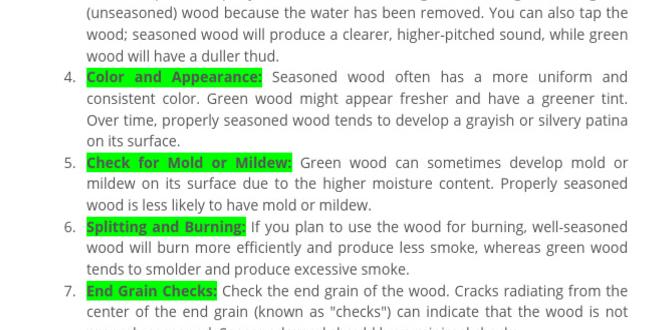Have you ever wondered how to tell if ash wood is seasoned? It’s a question many woodworkers and DIY enthusiasts ask. Using seasoned wood can make your projects much more successful. But how do you know if the ash wood you have is really dry and ready to use?
Picture this: You’re in a woodshop filled with beautiful ash planks. They look perfect! But if they aren’t seasoned, they can crack and warp. That’s why knowing how to tell if ash wood is seasoned is crucial.
Many people don’t realize that seasoned wood burns better. It creates less smoke and more heat. Isn’t it interesting that the difference between seasoned and unseasoned wood can change your entire experience? In this article, we’ll explore some simple ways to check if your ash wood is ready for your next big project.
Table of Contents
How To Tell If Ash Wood Is Seasoned: Essential Tips And Signs When Working With Ash Wood, Knowing Whether It Is Seasoned Is Crucial For Achieving Optimal Results In Woodworking, Burning, Or Crafting. Seasoned Wood Has Reduced Moisture Content, Making It More Stable, Easier To Work With, And More Efficient For Burning. Here Are Some Essential Tips And Signs To Help You Determine If Your Ash Wood Is Properly Seasoned. 1. Visual Inspection One Of The First Steps Is To Visually Inspect The Wood. Seasoned Ash Wood Typically Has A Darker Color Compared To Its Fresh Counterpart. Look For Any Signs Of Mold Or Mildew, Which Can Indicate That The Wood Is Still Moist. Additionally, Seasoned Wood Often Displays Cracks And Checking On The Ends, Which Is A Natural Drying Process. 2. The Weight Test Weight Is A Reliable Indicator Of Moisture Content. Freshly Cut Ash Wood Is Heavier Due To Its High Moisture Content. If You Lift A Piece And Find It Significantly Lighter Than Expected, It Is Likely Seasoned. Try Comparing Different Pieces; Seasoned Wood Should Weigh Less Than Unseasoned Wood. 3. Feel And Sound When You Knock Two Pieces Of Wood Together, Seasoned Ash Produces A Sharper, More Resonant Sound, While Unseasoned Wood Tends To Sound Dull And Thud-Like. The Feel Of The Wood Can Also Help: Seasoned Ash Will Feel Dry To The Touch. 4. Moisture Meter For The Most Accurate Assessment, Consider Using A Moisture Meter. This Tool Measures The Moisture Content Of The Wood. For Ash Wood To Be Considered Seasoned, The Moisture Content Should Ideally Be Below 20%. A Reading Between 6% And 12% Is Ideal For Many Woodworking Projects. 5. Time And Environment Lastly, Consider How Long The Wood Has Been Stored And Its Environment. Ash Wood Generally Requires At Least Six Months To A Year To Properly Season When Stored In The Correct Conditions, Ideally With Good Airflow And Protection From Rain Or Excessive Humidity. By Following These Tips, You Can Confidently Determine How To Tell If Ash Wood Is Seasoned, Ensuring That Your Woodworking Or Burning Experiences Are Both Productive And Enjoyable.

How to Tell If Ash Wood is Seasoned
Knowing how to tell if ash wood is seasoned can save you time and money. Seasoned wood has less moisture, making it burn better. To check, look for cracks in the ends; seasoned ash often shows these signs. The weight is another clue—seasoned wood feels lighter. Have you noticed how dry logs sound when you knock them together? That sound is a great indicator! Remember, using seasoned wood ensures a warmer and more enjoyable fire.Understanding Seasoned Wood
Definition of seasoned wood and its significance.. Differences between seasoned and unseasoned wood..Seasoned wood is wood that has dried out. It has less moisture than fresh wood. This makes it better for burning. It creates less smoke and burns hotter. On the other hand, unseasoned wood is still wet. It is heavy and hard to light. You’ll notice some key differences:
- Moisture Content: Seasoned wood has low moisture, while unseasoned wood has high moisture.
- Burning Efficiency: Seasoned wood burns better and longer.
- Weight: Seasoned wood is lighter than unseasoned wood.
Choosing seasoned wood can make your fire more enjoyable and safer!
Why is seasoned wood important?
Seasoned wood is more efficient for heating and produces less smoke. This means you get more warmth and cleaner air. Using seasoned wood is better for your fireplace and the environment.
Characteristics of Ash Wood
Physical properties of ash wood.. Common uses of ash wood in construction and furniture..Ash wood is known for its strength and beauty. It is light in color and has a smooth finish. Its unique grain patterns make it popular for furniture. Here are some key features:
- Strong: Ash wood is durable and can hold heavy weights.
- Elastic: It bends well without breaking, perfect for curved designs.
- Easy to work with: Carpenters love it because it shapes easily.
This wood is often used for:
- Furniture: Chairs, tables, and cabinets.
- Flooring: Beautiful planks add warmth to any room.
- Sports equipment: Used in baseball bats due to its strength.
What makes ash wood special?
Ash wood is special for its balance of strength, flexibility, and beauty. Its grain adds charm, making it a favorite in homes and sports. People love how well it works in different projects.
Signs of Seasoned Ash Wood
Visual indicators of seasoned ash wood.. Texture and sound when tapping seasoned wood..Seasoned ash wood has some clear signs that show it’s ready to use. Look for a rich, deep color. This often means it’s been dried well. The surface should feel smooth. Tapping the wood should produce a bright sound. This shows it’s not too wet inside. Here are some quick signs to help you:
- Color: Darker shades mean better seasoning.
- Texture: Smooth surfaces suggest dryness.
- Sound: A sharp tap indicates it’s seasoned.
Knowing these signs makes it easy to choose good wood for your projects.
How do you know if wood is seasoned?
You can tell by its color, sound, and feel. Seasoned wood is darker, makes a clear sound when tapped, and feels smooth.
Moisture Content Testing Methods
Using a moisture meter for accurate measurement.. Alternative testing methods (weight test, ovendry method)..Testing the moisture in ash wood is essential. A moisture meter provides quick and accurate results. You can measure the moisture content by placing the probes in the wood. High readings indicate unseasoned wood. If you need alternatives, consider these methods:
- Weight Test: Weigh the wood before and after drying. A significant weight drop means moisture loss.
- Ovendry Method: Dry a wood sample in an oven until it reaches a constant weight. This is very accurate.
Use these methods to ensure your wood is ready for use.
How do you test if wood is seasoned?
One way to test is by using a moisture meter. A reading below 20% often means the wood is seasoned.
Impact of Seasoning on Wood Quality
Effects of seasoning on appearance, stability, and durability.. Importance of proper seasoning for carving and finishing..Seasoning wood is very important for its quality. It can change how the wood looks, feels, and lasts. Seasoned wood has a cleaner, more attractive appearance. It also stays stable, meaning it won’t shrink or crack easily. This durability is essential for items made from the wood. Proper seasoning is key for carving and finishing, too. It helps the tools work better and gives a smooth surface. A well-seasoned piece of ash wood can make all the difference in your project.
How does seasoning affect wood quality?
Seasoning improves appearance, stability, and durability, making wood stronger and easier to work with.
- Looks better and cleaner
- Reduces chance of cracks
- Lasts longer for projects
- Helps tools carve better
Common Mistakes to Avoid
Misinterpreting visual cues of seasoning.. Ignoring moisture testing before projects..Many people confuse visual signs of seasoning. Seeing cracks and changes in color doesn’t mean your ash wood is ready. It might be a wooden actor in a drama but still wet inside! Always check moisture first. Forgetting to use a moisture meter is like making soup without tasting it—you might end up with a soggy mess. Avoid these blunders for great projects!
| Common Mistakes | Consequences |
|---|---|
| Relying on visual cues | Incorrect understanding of seasoning |
| Skipping moisture tests | Ruined projects and wasted materials |
Best Practices for Drying Ash Wood
Recommended drying methods (air drying vs. kiln drying).. Tips for monitoring wood during the seasoning process..Drying ash wood can be fun, like watching paint dry—but way more exciting! The best methods are air drying and kiln drying. Air drying takes time and fresh air, while kiln drying is fast but needs a hot oven. Keep an eye on your wood! Look for cracks or check moisture levels. Want to know how to do it better? Follow this chart for quick tips!
| Method | Time | Best For |
|---|---|---|
| Air Drying | 6-12 months | Patience and natural flavor |
| Kiln Drying | Days to weeks | Fast results without the wait |
To sum it up, drying ash wood is like cooking—find the right method and enjoy the results!
Frequently Asked Questions
Addressing common concerns about seasoning ash wood.. Clarifying myths surrounding wood seasoning..People often wonder about seasoning ash wood. Many myths can lead to confusion. Understanding the truth can help. Here are some common questions and answers:
How can I tell if ash wood is seasoned?
Look for cracks and lighter weight. Seasoned wood also makes a sharper sound when knocked together. Fresh wood feels heavier and has more moisture.
Do all types of wood season the same way?
No, different woods have unique drying times. Ash wood usually takes about six months to a year.
Is it bad to burn unseasoned wood?
Yes, burning unseasoned wood can create more smoke. This can lead to creosote buildup in chimneys, which is dangerous.
- Look for signs of cracks.
- Check the weight of the wood.
- Always prefer seasoned wood for burning.
Conclusion
To tell if ash wood is seasoned, look for a few key signs. Check for cracks, lighter weight, and a dull sound when knocked. Smell it; seasoned wood has a pleasant scent. If you find these signs, you’re ready to use it. For more tips, explore guides on wood types and drying methods. Happy woodworking!FAQs
What Are The Visual Indicators That Ash Wood Has Been Properly Seasoned?When ash wood is properly seasoned, it looks a bit different. You might see small cracks on the ends. The wood will be lighter and easier to lift. It also has a darker color compared to fresh wood. Lastly, it may have a few tiny holes from bugs. These signs mean the wood is ready to use!
How Can I Determine The Moisture Content Of Ash Wood To Know If It Is Seasoned?To check the moisture content of ash wood, you can use a moisture meter. This tool can tell you how wet the wood is. If the number is below 20%, the wood is likely seasoned. You can also feel the wood; seasoned wood usually feels dry and lighter.
What Differences In Weight Can I Expect Between Seasoned And Unseasoned Ash Wood?When you compare seasoned ash wood to unseasoned ash wood, you will notice a big difference in weight. Seasoned wood has been dried, so it loses a lot of moisture and is lighter. Unseasoned wood is heavy because it still has water inside. You can expect seasoned wood to weigh much less than unseasoned wood. This makes it easier to handle and use.
Are There Specific Sounds Or Techniques I Can Use To Test If Ash Wood Is Seasoned?Yes, there are ways to test if ash wood is seasoned. You can tap two pieces of wood together. If they make a clear, sharp sound, the wood is likely dry. If the sound is dull, it may still be wet. You can also check for cracks and see if the wood is lighter. Dry wood feels lighter than wet wood.
How Long Does It Typically Take For Ash Wood To Season Properly, And Does It Vary By Method?It usually takes ash wood about 6 to 12 months to season properly. This means it dries out and is ready to use. The time can change based on how you dry it. For example, stacking it in the sun might be quicker than drying it indoors.





